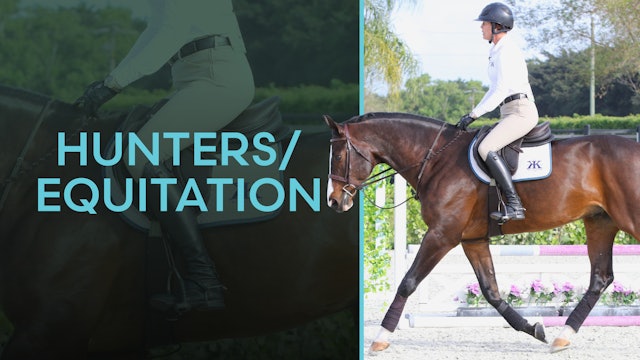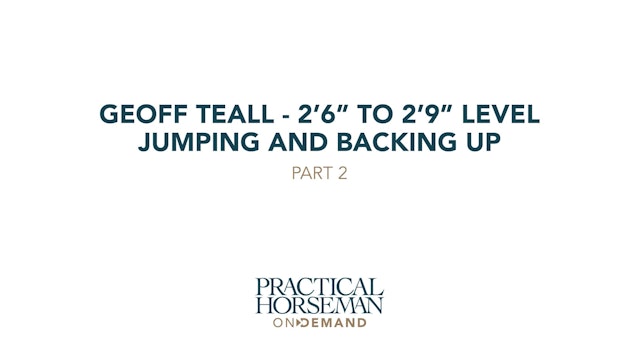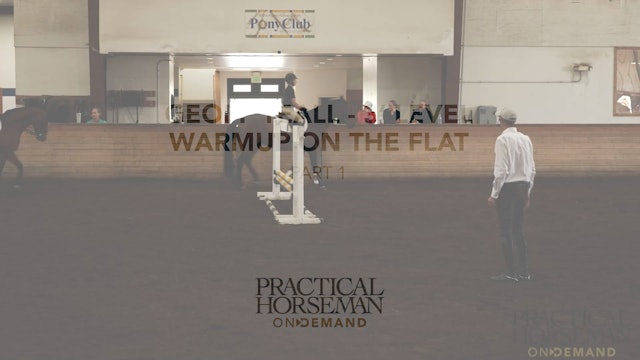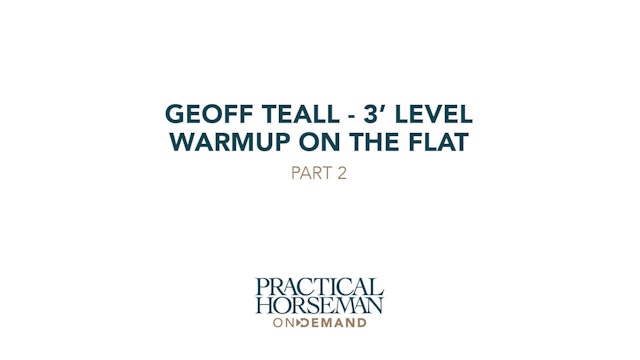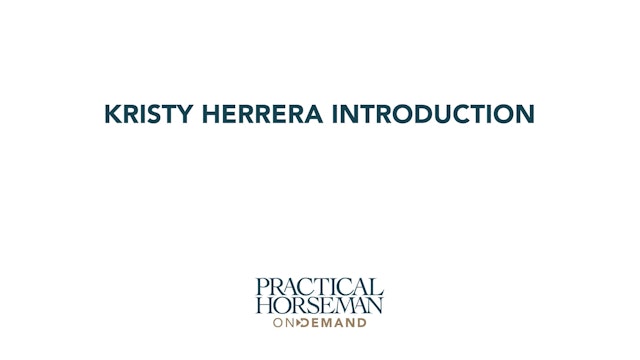Hunters/Equitation
Modern hunter classes were designed to test the qualities and attributes of a successful hunt horse negotiating natural obstacles (fences, hedges, stone walls). These classes are subjectively judged based on the horse’s performance over fences as well as its quality of movement under saddle on the flat.
Equitation classes are judged on the rider’s ability, form and skill to allow the horse to perform at its best, but the horse itself is not judged at all. The judging is subjectively based on the rider’s position, style, proficiency, accuracy, use of the aids, as well as an overall impression of complete and quiet control. Search for your favorite coach or by training topic.
-
2’6” to 2’9” Level – Jumping and Backing Up – Part 2
They continue working on stopping straight and backing after the jump. The horses start to balance back more so they can stop sooner. It is important that the moment the horse gives and backs up, the rider has to soften the hand to reward the horse and go forward. In some cases, the rider needs t...
-
3’ Level – Warmup on the Flat – Part 1
Geoff does a review of rider position as the group warms up on the flat. He also wants to make sure the horses work equally in both directions and that they stay relaxed and maintain a steady pace regardless of gait.
-
3’ Level – Warmup on the Flat – Part 2
Geoff does a review of rider position as the group warms up on the flat. He also wants to make sure the horses work equally in both directions and that they stay relaxed and maintain a steady pace regardless of gait.
-
Introduction | Kristy Herrera
Kristy introduces her series of hunter/jumper videos.
-
Helping a Rider that Pulls Out of the Corner | Kristy Herrera
Kristy McCormack (Herrera) explains and has a rider demonstrate how to help fix a rider that "pulls out of the corner." They start with cantering a ground pole and go to jumping a small fence. The focus is on having the rider get used to a forward hand position with a soft rein coming out of the ...
-
Correcting a Horse that Drifts | Kristy Herrera
Kristy McCormack (Herrera) explains and has a rider demonstrate how to help a horse that drifts. They start on the flat using counter flexion to help keep the horse straight. Then they progress to cantering a cavalletti also using a counter bend and outside leg to help keep the horse from driftin...
-
Improving Transitions on the Flat | Kristy Herrera
Kristy McCormack (Herrera) helps a rider work on transitions with a horse that can be fussy in the bridle. She wants the rider to maintain a steady contact and then add leg, having the horse move forward into the contact. She reminds the rider that in a down transition the leg has to go on first ...
-
Retraining a Jumper to be a Hunter | Kristy Herrera
Kristy give valuable tips on how to take a horse that is used to being a show jumper and schooling it so that it is appropriate for the hunter ring. She talks about the differences in jumps and lines between the two disciplines. She also explains how they teach a horse to relax over small jumps a...
-
Riding Counter Canter | Kristy Herrera
Kristy Herrera explains and demonstrates counter canter. Even though counter canter isn't shown in the hunter ring, Kristy uses it in training as an exercise that helps the horse become stronger and more balanced on both leads in both directions.
-
Holly Hugo-Vidal Introduction
Holly introduces her series of videos.
-
Fences on a Circle | For Rhythm and Track | Holly Hugo-Vidal | PART 01
Holly Hugo-Vidal shares an exercise of three obstacles set side-by-side that are ridden on a circle. Riders first canter over a ground pole. When that is smooth, they advance to a vertical and eventually finish over an oxer. If they focus on maintaining the correct balance, rhythm and track, the ...
-
Fences on a Circle | More on Focal Points | Holly Hugo-Vidal | PART 03
Holly Hugo-Vidal explains that the first of two focal points is set on the landing side of the jump, and the other about halfway around the circle. Riders determine if there are any canter issues before the first focal point, then repair the canter between the two focal points. When they pass the...
-
Fences on a Circle | Correcting Falling In | Holly Hugo-Vidal | PART 04
Holly Hugo-Vidal explains how the demo horse falls to the inside of the circle on the left lead, making the distance a little short. To fix this issue, the rider applies her inside leg pushing the horse to the outside rein so he approaches the jump bending in the direction of the circle. This hel...
-
Fences on a Circle | From Pole to Vertical to Oxer | Holly Hugo-Vidal | PART 02
Holly Hugo-Vidal explains that riders know they can advance from each obstacle—the pole to the vertical to the oxer—when they can canter over each element a few times in correct balance, meeting solid distance so their horses jump smoothly.
-
Seeing a Distance - Rhythm Over a Ground Pole | Holly Hugo-Vidal | PART 01
Holly has a rider on a green 4-year-old Thoroughbred trot two standards set on a diagonal. The rider focuses on keeping an even rhythm and riding straight though the center of the standards. She repeats the exercise at the canter, focusing on the horse’s rhythm, pace and straightness. Holly then ...
-
Rein Length and Shortening Reins | Holly Hugo-Vidal
Holly describes how rein length needs to allow a rider to make downward transitions while maintaining the hand position slightly above and in front of the horse’s withers. The rider shortens the reins by pulling the rein through the opposite hand as opposed to “nibbling” the hands up the reins.
-
Rider Position: Full Seat and Half Seat | Holly Hugo-Vidal
Holly describes different types of seats—three-point, two-point, a light seat and the driving seat. For galloping and jumping, a rider can use the two-point to encourage freedom off the horses’ back. A rider can lower to a light seat through the turns on a course to help balance a horse.
-
Rider Position: Hands and Arms | Holly Hugo-Vidal
Holly explains the hands’ primary and secondary grips on the reins and their placement—slightly above and in front of the withers. There is a bend in the elbow, which acts as a hinge to allow for a relaxed arm and following, yet still, hand.
-
Rider Position: Head and Eyes | Holly Hugo-Vidal
Riders should hold their heads so they are looking ahead at eye level and the brim of their helmets are parallel to the ground. They want to keep their balance in the center of the horse and turn their heads slightly in the direction they are going, using their eyes to look at the next fence.
-
Rider Position: Leg | Holly Hugo-Vidal
For a strong, balanced foundation, Holly explains that the rider’s heel should be slightly below the toe with the leg just slightly behind the girth so that there is a straight line from the rider’s hip to heel. The angle of the thigh and lower leg allows the calf to be against the horse so it ca...
-
Rider Position: Stirrup-Iron Placement | Holly Hugo-Vidal
Holly describes where the rider’s foot should be in the stirrup iron: She likes the inside branch of the iron to be cocked slightly back so the foot rests on the stirrup diagonally and closer to the outside branch. This helps with the flexibility of the ankle, allowing it to work like a spring.
-
Rider Aids: Leg and Spur to Go Forward | Holly Hugo-Vidal
To ask a horse to go forward, the rider squeezes with her leg. If she doesn’t get the desired effect, she turns her toe out to use the spur, what Holly describes as “telling” the horse to move forward. If a rider uses the leg and spur together, it will make the horse numb to the aid.
-
Rider Aids: Slowing Down a Horse | Holly Hugo-Vidal
Holly explains how a rider can use her body weight to slow a strong horse. To ask a horse to slow down, first the rider would close her hand. If he didn’t respond, she would then close her hand and bend her elbow. If that didn’t work, she would lean back, being careful not to drive with her seat.
-
Related Distances on Straight Lines | Holly Hugo-Vidal
Holly Hugo explains a related distance between two fences in a line. If a rider meets the first jump of the line perfectly, she may just need to maintain the horse’s balance down the line and jump the center of the second fence. But if she meets the first jump short or long, she needs to adjust t...

